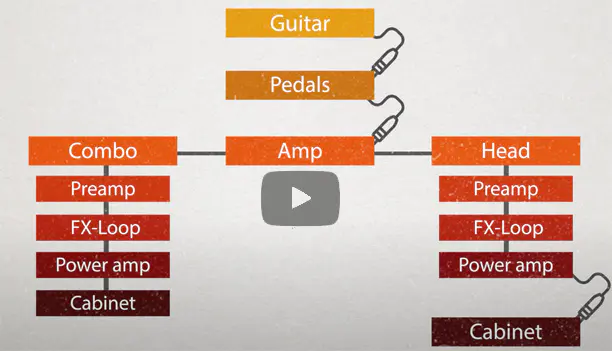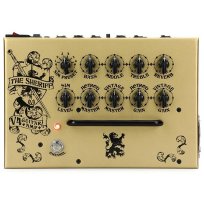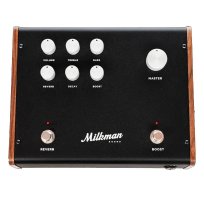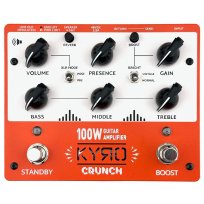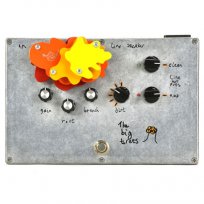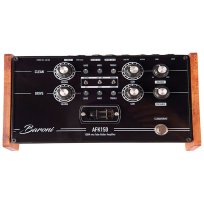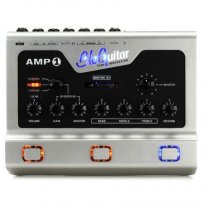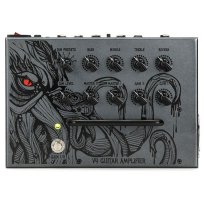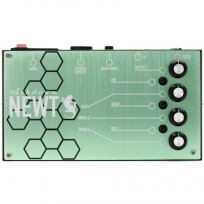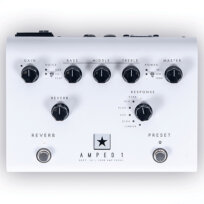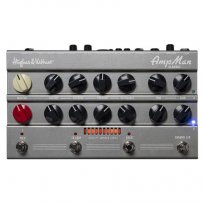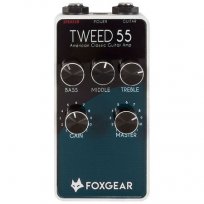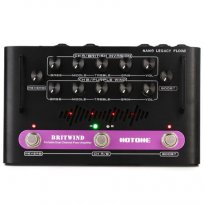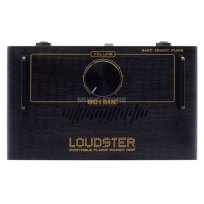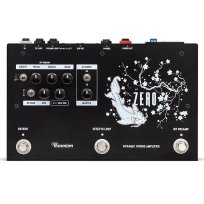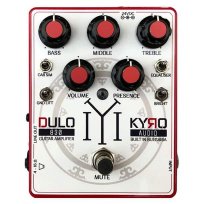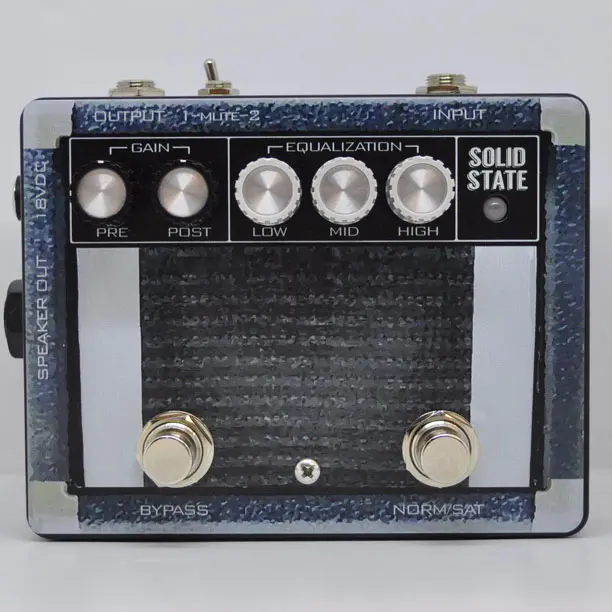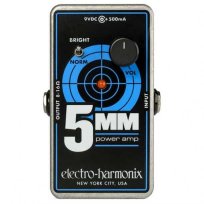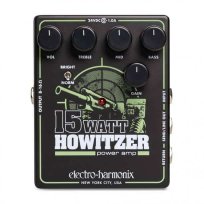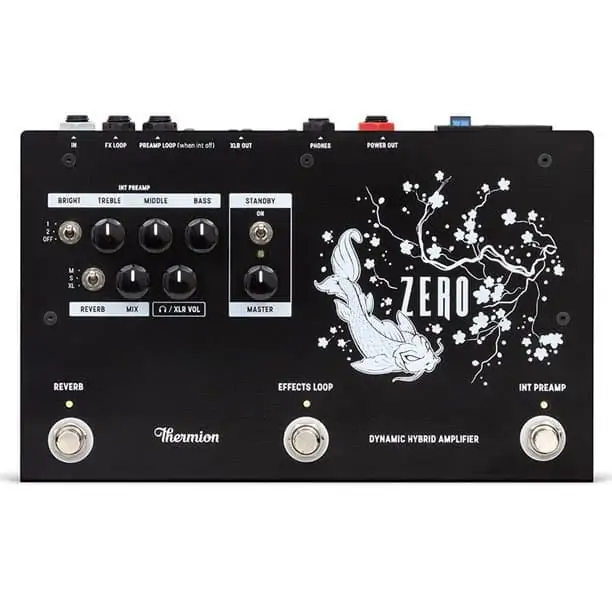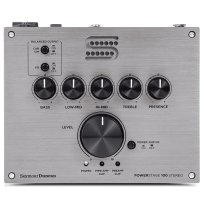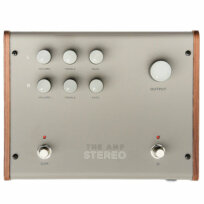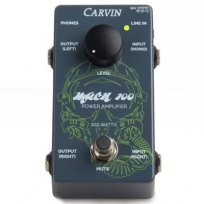This article is about guitar amplifiers in a pedal format, not simple preamp-style pedals or amp/cab simulators.
—
Most electric guitarists agree that having to carry an amplifier around to gigs and rehearsals sucks royally. This sentiment tends to grow stronger as the years go by when lower back problems due to protracted “amp shlepping” materialize.
Luckily for us and future musicians, the ongoing trend of circuit shrinking made it possible to fit powerful amplifiers inside increasingly smaller enclosures – as small as stompboxes.
In this article, we take a look at the best power amp pedals you can buy to make your life easier by replacing your bulky and heavy amp head with a much more portable and lightweight solution.
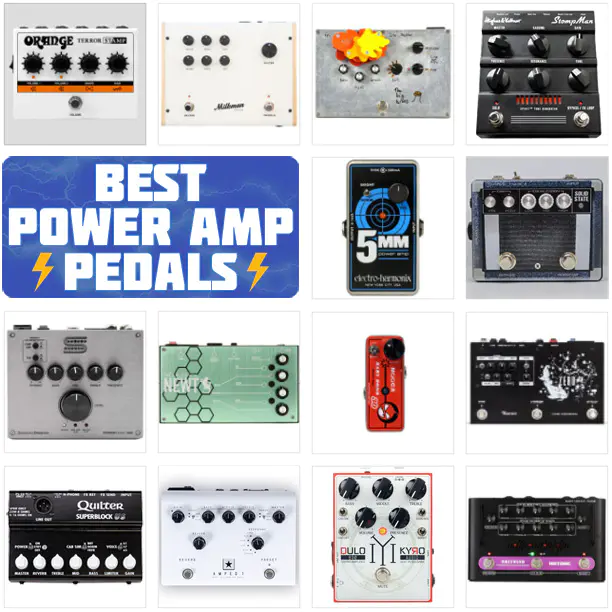
Ready to buy? Please use our affiliate links to Sweetwater, Reverb.com, Amazon, and the other independent stores – that’s what’s allowing us to keep this site alive at no cost to you!
—
Article updated on July 26, 2023
Pedal Amp Vs. “Preamp”
If you need a refresher on the way power amps work… Not convinced yet about replacing your amp head with a pedal-size amp? ...click here to expand a brief chapter about it.
As you probably know already, wattage is an important spec related to power amps. This is because watts = electrical power, and the more watts you can send to a speaker/cabinet the more volume it can generate. But that’s not the whole story… Cabinets and speakers have another important spec: impedance, calculated in “Ohms.” In most cases, a lower ohm value implies a better quality speaker, but 4-ohm cabinets require twice as much power as 8-ohm ones to deliver the same volume, so keep your cabinet’s Ohms in mind when choosing your power amp, because if you have a 4-ohm cab you will need more power, while if you have a 16-ohm one you may not want to push 200w into it! Therefore, it’s always good to be careful when matching a powerful amp with a high-ohm cab, because the latter can blow up if it’s fed too much power. Also, if you are a real nerd, you may want to look into the differences between Cass A, B, AB and D power amps. Many electric guitarists are in love with tubes, and for good reason. Tube-based amps tend to confer to the signal a character that’s pleasing to the ear, often described as “warmer,” “rounder,” “smoother” and “more full-bodied” than the one imparted by transistor (aka solid-state) ones. Tubes also respond in a more natural-sounding way when saturated: they clip more gradually than a solid-state device, which makes them more touch-sensitive and responsive. On the other hand, tubes wear out more quickly and are more fragile than transistor-based designs – on average, they start sounding bad after around 8-10k hours of playing. While you might have to spend a little more, having a tube preamp as the front end of your amp can help you retain some of the organic saturation, compression, and warmth of an all-tube amplifier. Tim Marcus of Milkman Sound says “There is no substitute for the marriage between a magnetic guitar pickup and the first stage of a tube amplifier, and this is something that is missing with modern pedalboard setups.” Here’s a list of the best pedalboard tube power amps. A true boutique gem, the 50-watt version of The Amp features a Class D hybrid tube/solid-state amp that can fit on your desktop (or your pedalboard, although it’s not super-compact). It uses a 12ax7 preamp tube that can be pushed or overdriven just like any tube amp. The power stage can be run into a speaker or DI out into a recording interface or PA. It also works in “pedal mode,” as a gain stage or tone sweetener. The Amp 50 also features classic onboard effects found in many vintage amps: spring reverb and tremolo. Its bigger brother, the Amp 100, gives you more power and adds a footswitch-triggered boost circuit, but loses the reverb footswitch, which is very handy indeed. The reverb is a digital circuit with controls for decay and blend and can deliver very musical reflections ranging from room to the classic drippy spring reverb. Just like The Amp 100, the 50 has optional cab simulation and can be run at pedal level, into a speaker cab, or into headphones for at-home playing. Here are some other quality alternatives with a tube-based circuit: — Solid-state amplifiers may not sound as good as tube ones (although always remember that, in music, everything is subjective), but they can sure beat them on sheer power, which subjective is not! In this list, you’ll find some small beasts that have the potential to make your room’s wall shake. But attention! High power amps work well with lower ohm, quality cabs, which can be expensive if you don’t have one already. If you have a cheap 16-ohm cabinet, a 100w+ amp is wasted on it, and you run the risk to blow up the speaker. $499 | Click title for video. Buy it on | zZounds | Sweetwater | Thomann | Amazon | Reverb. Not technically a pedal (no footswitch), this is a mini amp head with a clean preamp section made to fit on your board. It has a big Master volume knob that can be adjusted with your foot (careful, though, things can get real loud real quick!), and a 4 band EQ (including Presence) for tone sculpting. It can drive any 4-8ohm speaker cab with up to 200 watts. Unlike the smaller and less powerful (but cheaper) Powerstage 170, it has aux-in and headphones out and switchable Cab simulation on the DI output, which comes in handy when going direct into a PA or a recording rig. About one-tenth the size of most amp heads this powerful, this is a great option for players with quality cabs who appreciate volume and headroom, but may not sound great at lower output levels. Not your thing if your cab is above 8-ohm. — — A power range of 50-100w might be the right compromise between power and low-level fidelity. This is because very powerful amps tend to sound poor at the lower volumes used during intimate rehearsals, while low-power ones will distort more easily and not deliver enough volume for a loud live show situation. The pedals in this list offer a sweet-spot wattage that should work well in both environments. Their power range works well with cabinets of any impedance. $299 | Click title for video. Buy it on zZounds | Sweetwater | Thomann | Amazon | Reverb. Built by an expert boutique UK-based amp maker, this is a 60w amp pedal with 2 channels sharing a 3-way EQ, each with its own Gain and Volume knobs and a specific 3-way voice switch: Rythm, Clean + Lead for Ch 1 and Bright, Dark + Flat for Ch 2. The boost, activated by the right footswitch, has its own level knob (red). It doubles as a drive. The gain and volume levels are customizable for each channel, while EQ and Boost settings are shared. It can power any 8- to 16-ohm cabinets or plug directly into a console or a PA with the optional analog cab simulation. It also features an aux-in and headphones out for silent practice. It also features an integrated effects loop on the side panel. These are some other board amps in the same power bracket. —— These power amps are not too dissimilar from the ones featured in the previous bracket, simply a little less powerful, i.e. quieter, and probably not ideal for 4-ohms cabs. Less power also means a more affordable price (when features are comparable) and a better sound at lower volumes. $275 | Click title for video. Buy it on Sweetwater | Thomann | Amazon | Reverb. Although it doesn’t have a footswitch, this outstanding solid-state mini amp is built to sit on a pedalboard, and it comes in two flavors: US (pictured) and the Superblock UK. It sends 25 Watts of power to your speaker (or just 1 Watt, when powered with a conventional 9v power supply) and provides 3 Amp Simulations (’57 Tweed, ’61 Blonde, and ’65 Black panel voicings for the US versions and JMP, AC Normal, and AC Top Boost for the UK one), 2 Cab Simulations, Limiter, Reverb and a 3-band EQ section. As if that wasn’t enough, it also offers generous routing capabilities, with FX loop, XLR out, and headphones out. Here are some other power amp stompboxes in the same power range: — That’s right, 2.5 watts are actually enough to drive a small 16-ohm speaker, but don’t expect that amp to sound very loud. This being said, it’s a well-known fact that many huge-sounding guitar parts in some iconic rock records were recorded on very small amps. The amps in this list may not be loud enough for a live performance, but they can be a secret studio weapon and, at once, perfect for low to medium-volume rehearsals. The Acorn Amps Solid State is a boutique, hand-made pedal that recreates the sound of a Peavey Decade, a tiny and affordable 10-Watt combo amp used by many broke guitarists of the ’90s but also – among others – Josh Homme of Queens of the Stone Age, who used it for most of his recordings. It incorporates the TDA series class-AB power amp device from the original amp design and can produce a range of tones from bright cleans to ultra-gain breakup. It can be used as either a preamp in your pedal chain or as a standalone 10-watt amplifier plugged directly into a speaker cab. A toggle switch lets you select between sending the signal out before or after the power amp circuit. Here are some other non-boutique alternatives with a similar power: — Since the last time I checked humans have two years and – more importantly – stereo pedals are all the rage right now, it may make sense to go for a stereo or dual-channel power amp. These are our recommendations in this niche. A feature-packed, class D, cleverly designed portable guitar amp by a boutique builder with two outputs, each delivering 40w of power. And it looks good too! The Zero features highly flexible routing including a stereo fx loop, bypassable preamp stage, XLR outs with cab modeling for direct recording and 1/4” outs to drive speakers. Also comes with onboard stereo reverb, bright channel, standby switch and 3-band tone stack. The three footswitches activate the reverb, the FX loop and the internal preamp. Here are the only two other options, as we speak. Do We Still Need Amps? (Paul Davids) EHX Magnum 44 vs Seymour Duncan PS170 vs Vox MV50AC (That Pedal Show) Mooer Baby Bomb vs EHX Magnum 44 vs Seymour Duncan PS170 (Gear, Stuff & Things)
...click here to expand a brief chapter about it.
The Advantages of a Pedal Amp
How Much Power? Ohms vs Watts
• Best Power Amp Pedals with Tubes
Milkman The Amp 100
• Super-High-Power Solid State Pedal Power Amps (150-200w)
Seymour Duncan Powerstage 200
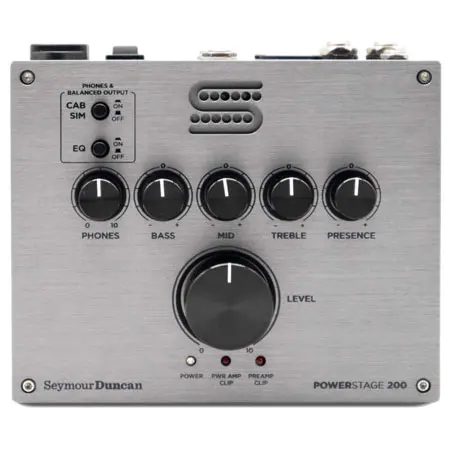
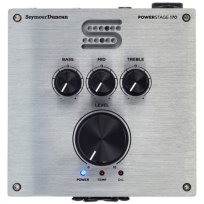
• Best High-Power Solid State Pedal Power Amps (50-100w)
Blackstar Amped 1
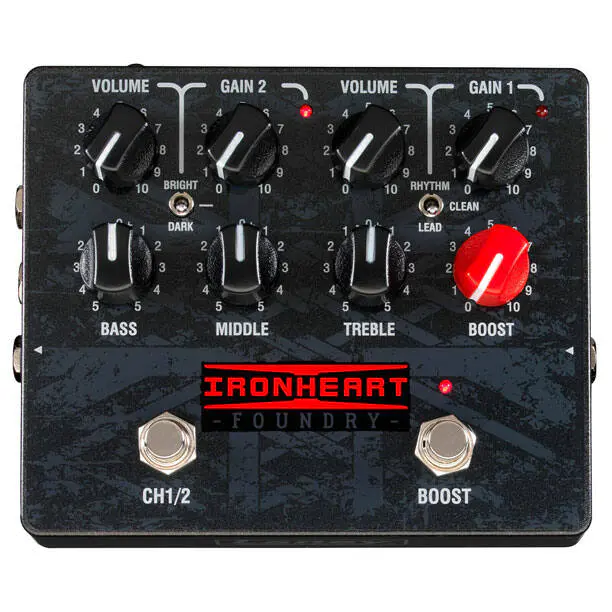
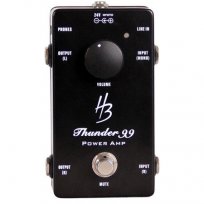
• Best Medium-Power Solid State Power Amp Pedals (11-49w)
Quilter Superblock
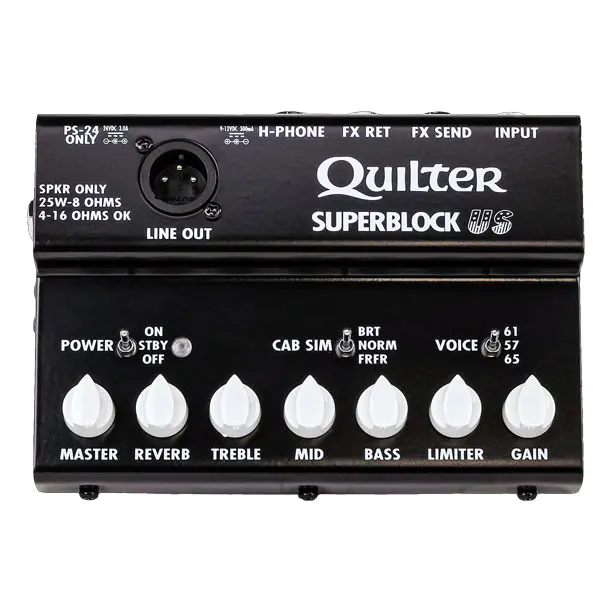
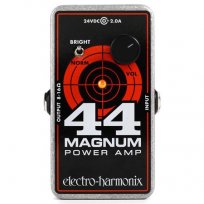
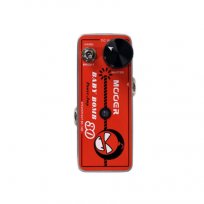
• Best Low-Power Solid State Power Amp Pedals (2.5-15w)
Acorn Amps Solid State
• Best Stereo Power Amp Pedals
Thermion Zero

Videos about Pedal-Sized Power Amps















